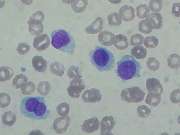Researchers exploit cancer's faulty defence mechanism

Researchers in Germany have found a new way to exploit the differences between cancer cells and normal cells that could lead to new treatments.
The discovery suggests that experimental drugs that target a protein called DNA-PKcs could be particularly effective in cancer patients whose tumours bear a specific fault, although this idea will need testing in clinical trials.
The research team, led by scientists at University Hospital of Cologne, focused on cancer cells that lack the crucial ATM protein, which is normally involved in directing a cell's response to damage.
"Normally, ATM is a molecular 'triage nurse' inside our cells, assessing damage, stopping cells dividing, then repairing damaged DNA. But if the damage is too severe, ATM can also trigger damaged cells to commit suicide," explained Dr Mark O'Driscoll, a Cancer Research UK-funded DNA repair expert at Sussex University who was not involved in the research.
"But in about one in ten cancers, ATM is missing or damaged, meaning that the cells can keep growing despite damage from drugs or radiotherapy," he added.
This is particularly true of a form of leukaemia called chronic lymphocytic leukaemia, or CLL, where lack of ATM is linked to particularly poor survival rates and the development of drug resistance.
ATM is also damaged or missing in a minority of head and neck cancers, and in a form of non-Hodgkin lymphoma called mantle cell lymphoma.
Although lacking the ability to commit suicide, cancer cells lacking ATM can still repair DNA damage – albeit less efficiently - using a pathway driven by the DNA-PKcs protein – effectively a 'back-up mechanism' to protect against ATM loss.
The Cologne team showed, in a series of lab experiments, that disrupting DNA-PKcs in cells that lacked ATM had a lethal effect, triggering the suicide pathway. They confirmed their findings in mice with a form of blood cancer.
Their finding, published in the journal Science Translational Medicine, mirror the discovery some years ago that blocking an enzyme called PARP could kill cancer cells that had faults in the BRCA 1 or BRCA2 genes. This has led to the development of drugs called PARP-inhibitors, now undergoing large-scale trials for breast and ovarian cancers.
The Cologne team's study, said O'Driscoll, is "very comprehensive and exciting study" and welcomed the focus on ATM-deficient cancers.
"Much of the recent research into DNA repair mechanisms - which can drive cancer development and help cancers become resistant to treatment - have focused on blocking a molecule called PARP. So it's good to see these researchers focusing on a second pathway involving the ATM protein," he said.
"If drugs that safely and effectively target cancer cells that lack this protein can be developed, the potential to use them in combination with other therapies could be vast.
"Ultimately, this could lead to the development of new, more personalised ways to treat some of the most aggressive forms of cancer, and we'll be keenly following future developments," he added.
A molecule that targets DNA-PKcs, known as CC-115, is currently being tested in US patients with a variety of tumours.
More information: Riabinska, A. et al. Therapeutic Targeting of a Robust Non-Oncogene Addiction to PRKDC in ATM-Defective Tumors, Sci Transl Med (June 2013). DOI: 10.1126/scitranslmed.3005814
















